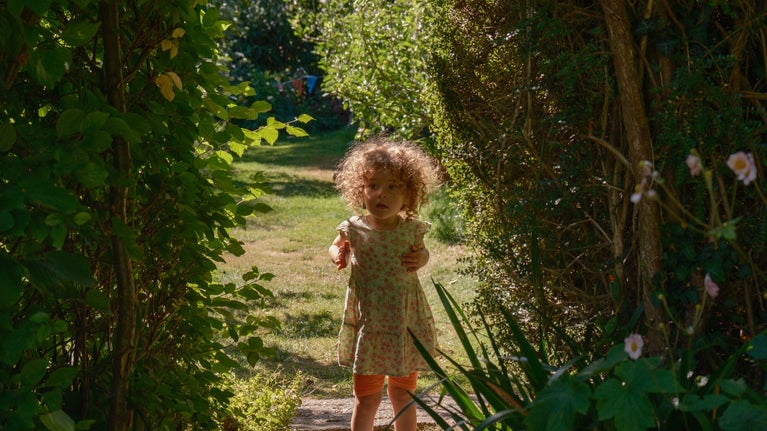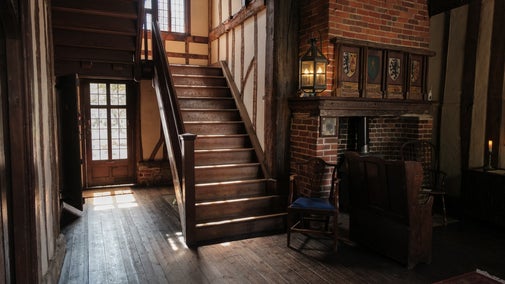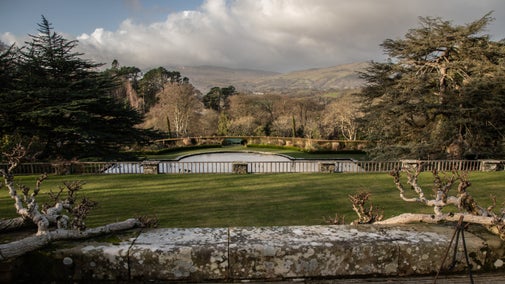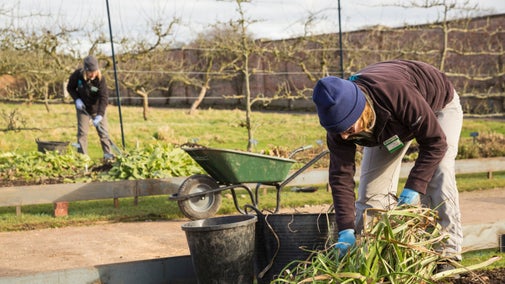
Discover more at Paycocke's House and Garden
Find out when Paycocke's is open, how to get here, things to see and do and more.

The tranquil Arts and Crafts-style tiered cottage garden, created during the renovation of Paycocke's, is a hidden gem. Based on the original design-work of Miriam Noel who lived at Paycocke's during its restoration, the layout includes space to enjoy our tea-room offerings, a croquet lawn and a new wildflower garden.
Adorning Miriam’s Garden Room is the glorious wisteria sinensis. Believed to have been planted by Miriam, it’s over 100 years old and frames the Buxton family emblem, pargetted in the plaster above the doorway during the house's restoration by Lord Buxton. The original brick paving takes two forms and offers two pathways to the garden.

The upper lawn is enclosed by a wood and metal colonnade draped with roses and clematis. In August 2012, this lawn formed the main site of an archaeological dig. Now, it is laid out with tables and chairs for visitors allowing visitors a larger outdoor space to enjoy our tea-room offerings.
The long herbaceous borders which frame the main lawn were given serpentine edges and a gravel pathway in 2012. They were planted to display a variety of perennials and annuals including several specimen trees and roses, many of which are still there to be seen. Plans are being forged for the future, to refreshen this area with some new planting.
The native mixed hedge at the end provides a living screen, with archways at either end to entice you to discover what lies beyond.

In past years this area was maintained as a produce garden for vegetable and cut flowers. Now it is being slowly transformed into a space for wildlife to flourish. We hope visitors will enjoy the space spotting different wildflowers, insects and birds, as well as herbs and fruit trees. A place to slow down and connect with nature.
Garden waste is collected at the bottom of the garden and recycled, providing a supply of compost and leaf mould. A dead hedge has been constructed with woody cuttings, stacked to provide homes and shelter for the insects and small animals that use the garden.
A small pond is the garden’s final feature, laying next to the boundary. The pond is a connection to earlier centuries when the house’s grounds extended down to the River Blackwater. The water would have been a vital resource for the washing of wool, but also in the Victorian era when the back of the house had a brewery.
The garden trail is the perfect way to get to grips with nature and to have fun as a family. The trail helps explorers to find out more about our house and garden.
The lawn is the perfect setting for some authentic garden games. Our croquet set is always out in good weather and is fun for all ages. If you fancy a challenge, try the quoits game and see how far away you can score with your hoop.

Find out when Paycocke's is open, how to get here, things to see and do and more.
Uncover the story behind Paycocke’s House, a glorious example of Tudor craftmanship with quaint beamed rooms. There’s so much to discover here in this unique merchant’s home.

Paycocke’s has an intriguing history spanning more than 500 years. Constructed in 1509, it has witnessed a religious reformation and survived a civil war.

Originally built by a successful woollen cloth merchant, discover more about the family who started the development of this fascinating place.

Volunteers at Paycocke’s House and Garden play a vital role in welcoming visitors and sharing knowledge about the building and its history. Discover how you can get involved.

Explore the unexpected at Paycocke’s. Entry to the house is by guided tours, led by passionate and knowledgeable volunteers, which will reveal the hidden treasures and stories of the house. To guarantee your preferred time slot you may wish to book a tour in advance. Find out how, here.

From 18th-century water gardens and Arts and Crafts landscapes to intimate woodland gardens, there are so many places to discover.

Discover our gardeners’ top tips so you can make the most of your garden, plot or window box.
